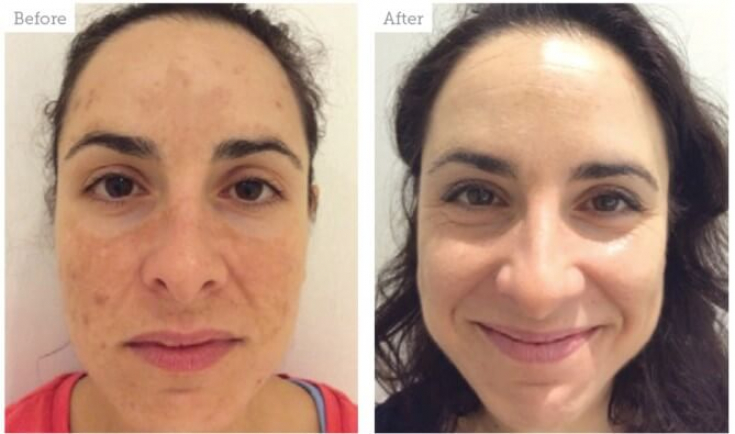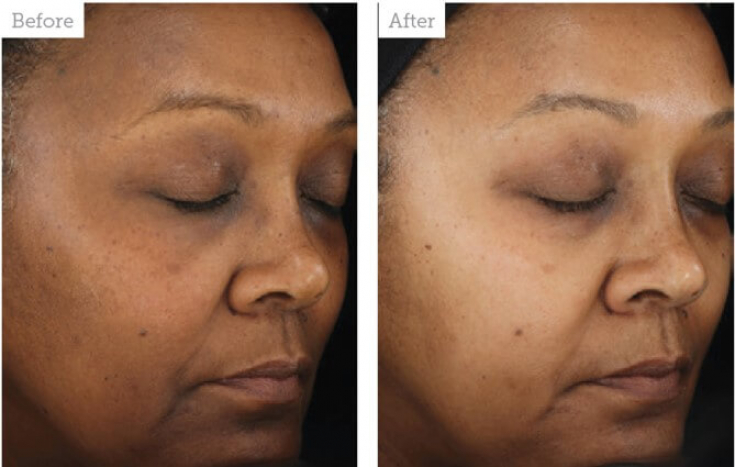In 1975, Dr. Thomas Fitzpatrick developed a system that measures a patient's skin response to ultraviolet radiation. Today, this system is known as the Fitzpatrick scale and is used by dermatologists and cosmetologists around the world to determine the appropriate level of exposure when choosing treatments such as chemical peels and laser therapy.
In this article, experts talk about how different skin phototypes react to excessive exposure to solar radiation and what methods provide effective and safe treatment of pigmentation for a particular Fitzpatrick skin phototype.
How different Fitzpatrick skin phototypes react to solar radiation
The Fitzpatrick scale covers 6 skin phototypes – from I (skin that never tans and always burns) to VI (skin that always tans and never burns). Aesthetist Askari Townshend states that phototype I skin is much more prone to developing cancer than VI because it does not have the protection that the melanin pigment provides.
Dr. Townshend explains to his patients that tan – nothing more than damage to the skin, to which it reacts with the production of melanin.
Sunburn – nothing more than damage to the skin, to which it reacts with the production of melanin.
Fitzpatrick phototype I–IV skin and ultraviolet light: characteristic problems
Fair and dark skin may react differently to sun exposure. Dermatologist Justine Hextall explains that lighter skin photodamage shows up as wrinkles and laxity, reticular veins, and lentigo, among other things. Red-haired people with Fitzpatrick skin phototype I produce pheomelanin, which does not provide reliable skin protection from ultraviolet radiation.
Fair skin is more prone to the appearance of signs of aging than dark skin. Dermatologist Sandeep Cliff claims that dark-skinned patients retain their youth for a longer time; they have natural protection, and therefore the signs of aging in them appear much later than in patients with fair skin.
At the same time, the doctor, based on his own observations, notes that photodamage to the skin is increasingly common in young patients, even at the age of 21.
How skin of Fitzpatrick phototypes V–VI reacts to ultraviolet radiation
Regarding dark Fitzpatrick skin phototypes, Dr. Gextall states that the skin's response to sun exposure is more dependent on the amount and type of melanin produced by melanocytes. Patients with skin type VI produce predominantly eumelanin – a very dark pigment that can effectively block UV photons and protect the skin from the damage they cause.
However, the doctor also emphasizes: “Many patients with skin phototypes IV-VI find that they do not need to use sunscreen. However, this is not the case: although dark skin is less prone to the formation of wrinkles and sagging, it is prone to pigmentation-related problems such as melasma.
Kaidby et al demonstrated that the epidermis of dark-skinned patients (Fitzpatrick phototype not specified) provided an average SPF of 13.4. The photoprotective role of melanin was assessed by comparing the transmission of ultraviolet light through skin samples of dark and Caucasian phototypes. UVA transmission was measured using fluoranthene. UVB transmission was measured by monitoring erythema induced by exposure to a 150 watt xenon arc lamp or an FS-20 lamp. It has been found that, on average, 5 times more ultraviolet (UVA and UVB) penetrates into the upper layer of the dermis of the Caucasian skin phototype than into dark skin.

Pigmentation disorders and methods for their correction for different Fitzpatrick skin phototypes
Pigmentation disorders may appear on the skin depending on its Fitzpatrick phototype. So, on light skin (I–IV phototypes) freckles may appear, which increase over time under the influence of ultraviolet radiation and visually age the face.
Dr. Townshend notes that type IV & VI patients often do not use sunscreen, resulting in dyschromia – the appearance of light or dark spots on the skin.
Preparation of the skin for the correction of pigmentation disorders depending on the phototype
The patient's skin must be properly prepared before starting any procedure. It is important to ensure that the chosen treatment plan will not cause further damage to the skin.
Esthetician Rita Racus uses the Visia system to scan the skin and assess its condition at the level of various layers. After that, the training course is selected depending on the depth of damage, for example:
- vitamin A (the concentration is selected depending on the degree of damage);
- hydroquinone, retinol and treninoin;
- treatments on fair skin are sometimes performed without special preparation, but in this case the results are less pronounced.
To correct pigmentation disorders, the most commonly used:
- laser and IPL therapy;
- chemical peels;
- Hydroquinone-based preparations.
Laser and IPL therapy for the correction of skin pigmentation disorders depending on the Fitzpatrick phototype
IPL and laser therapy are effective in correcting pigmentation disorders, but care must be taken when treating melasma to avoid exacerbating the problem.
Dr. Gextall advises to first test on a small area of skin. At the same time, pain and discomfort of the patient can be very important indicators of problems associated with the safety of the procedure. If the patient complains of pain, cooling the skin or applying an anti-inflammatory agent should be considered.
Dr. Townshend uses a 3JUVE device with an IPL tip in his clinic, wavelength – 585 nm. This system allows not only to eliminate dark spots, but also to solve the problem of damaged vessels and photodamage.
IPL- and laser therapy are more suitable for correcting pigmentation disorders in patients with fair skin phototypes.
poikiloderma – a skin disease characterized by areas of hypopigmentation, hyperpigmentation, telangiectasia, and skin atrophy that most commonly affects the chest or neck region. High-intensity pulsed light is excellent for this disease, while lasers are not able to eliminate all the above symptoms at the same time.
For those with dark Fitzpatrick skin phototypes, the use of laser or IPL devices is not recommended, since the radiation affects not only areas with pigmentation disorders, but also healthy areas of the skin. Therefore, such procedures are safer for fair-skinned patients.
Dr. Gextall uses the Lumenis M22 Multi-Purpose Platform, the versatility of which allows IPL and then Fractional Laser skin treatment with just one push of a button. The M22 is suitable for skin phototypes IV & VI, as the doctor can choose the desired wavelength, and fractional pulses allow you to safely deliver the optimal amount of energy to the target area.
Features of the use of chemical peels for different skin phototypes according to Fitzpatrick
Chemical peels are an alternative to laser and IPL therapy in solving pigmentation problems. For example, Dr. Gextall uses The Perfect Peel, a median peel that contains glutathione, kojic acid, TCA, retinoic acid, salicylic acid, phenol, vitamins and minerals.
For patients with Fitzpatrick skin phototypes IV & VI, there is an increased risk of post-inflammatory hyperpigmentation after peels, therefore, as part of the preparation of the skin for the procedure, a tyrosinase inhibitor is used to block melanin production.
Dr. Rimmer offers his patients chemical peels, most often – The Perfect Peel or pHformula. Some peels can be used without pre-treatment of the skin, but for dark-skinned patients, the doctor always prescribes a two-week pre-peel preparation in order to reduce the risk of discoloration.
Preparations based on hydroquinone – great choice for any Fitzpatrick skin phototype
For some patients with hyperpigmentation of the skin and melisma, Dr. Gextall prescribes a course of whitening creams – Pigmanorm or The Perfect Peel Bleaching Cream which contains 4% ridroquinone, licorice, arbutin and kojic acid.
Dr. Townshend also uses hydroquinone based products because, with the right protocol, hydroquinone can produce excellent results on photodamaged skin. At the same time, the Fitzpatrick phototype does not matter – the drug is relatively safe for any patient, has no recovery period, and is also available for home use.
Hydroquinone-based preparations are safe for all skin phototypes.
Dr. Townshend prescribes ZO products to his patients – Melamine and Melamax, recommending that they be applied twice a day for 4 to 6 weeks. The doctor also recommends avoiding prolonged sun exposure and applying SPF products to the skin. However, the above products are contraindicated for pregnant and lactating mothers.

Fig. 1: Patient before and after 15 weeks of treatment with ZO and injections of botulinum toxin in three zones. Photo: Elizabeth Rimmer
Dr. Rakus prescribes the Obagi CRX system, which contains hydroquinone at a concentration of 4%, to his patients. One of the advantages of such drugs is that they can be used in the summer period. CRX also contains vitamin C, glycolic acid and SPF. The products are soft, do not damage the skin and do not cause redness, dryness or flaking. In addition, Dr. Rakus emphasizes that Obagi CRX products rejuvenate skin cells at the DNA level and promote its natural renewal.
For more severe cases of pigmentation disorders, Dr. Rakus prescribes Obagi Nu-Derm products, which, in addition to hydroquinone, contain hyaluronic acid, tretinoin and SPF and are more powerful.
After completing the course of treatment and achieving the desired results, supportive procedures must be carried out to maintain the effect obtained.
Dr. Gextall recommends sunscreen and active topical serums, depending on the type of problem being treated. Also, the doctor in some cases recommends LED therapy – about 6 treatments over 6 months. To fix the result, you can also perform a procedure using IPL or fractional laser – once or twice a year. Of course, the choice of procedure and the frequency of its implementation depends on the individual characteristics and requirements of the patient.

Fig. 2: the patient before and 24 weeks after treatment with the Obagi Nu - Derm System with 1.0% retinol. Photo: Obagi Medical
Read also: Modern therapy for hyperpigmentation: methods and means
Dr. Rakus recommends that his patients apply SPF 50+ products to their skin, namely Obagi Sun Shield Matte SPF 50. Dr. Cliff offers his patients NeoStrata Sheer Physical Protection SPF 50 broad spectrum physical protection product to protect the skin from ultraviolet radiation , which has an antioxidant effect, protecting DNA from damage. The product is suitable for all Fitzpatrick skin phototypes and does not leave white marks on the face.
Adapted from Aesthetics.







Add a comment